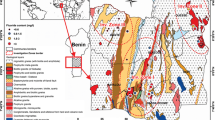Abstract
The Porto Alegre region, Southern Brazil, comprises a fractured aquifer system constituted by pre-Cambrian granitic and gneissic rocks, and a porous aquifer system formed by Cenozoic muddy–sandy to sandy sediments. A model is presented for the origin of the fluoride in the groundwater of the fractured aquifer system, based on ionic interrelations, a statistical analysis of physicochemical parameters and geochemical modeling. The fluoride is present at levels of up to 6.13 mg/L in groundwater and it arises due to the dissolution of secondary fluorite filling fractures in the granitic and gneissic rocks. The dissolution of fluorite occurs at the same time as calcite and dolomite solubilization. The statistical analysis identified three chemically distinct groups (named 1, 2 and 3) and two subgroups (1A and 1B) of groundwater in the fractured aquifer. The most significant differences between these groups are the different concentration ranges of fluoride, calcium, bicarbonate, magnesium, total dissolved solids and chloride and pH values, as well as the correlations between them. The compositional evolution of each groundwater group is governed mainly by how much high-salinity groundwater from the porous aquifer system is mixed with them and the different thermodynamic equilibrium conditions of calcite, dolomite and fluorite.











Similar content being viewed by others
References
Agarwal M, Rai K, Shrivastav T, Dass S (2003) Deflouridation of water using amended clay. J Clean Prod 11:439–444
APH Association, AWW Association, WPC Federation (1998) Standard methods for the examination of water and wastewater. American Public Health Association, Washington, DC, p 1268
Ashley RP, Burley MJ (1995) Controls on the occurrence of fluoride in groundwater in the Rift Valley of Etiopia. In: Nash H, McCall GJH (eds) Groundwater quality. Chapman & Hall, New York, pp 45–54
Brookins DG (1988) Eh–pH diagrams for geochemistry. Springer, London, p 176
Castro E, Schulz C, Mariño E (1997) El água potable en la Provincia de La Pampa. Consecuencia por la presencia de fluor y arsénico. In: Actas II Reunión Geología Ambiental, San Salvador de Jujuy, Argentina, pp 43–55
Bundschuh J, Bonorino G, Viero AP, Albouy R, Fuertes A (2000) Arsenic and other trace elements in sedimentary aquifers in the Chaco-Pampean Plain, Argentina: Origin, distribution, speciation, social and economic consequences. In: Bhattacharya P, Welch AH (eds) Arsenic in groundwater of sedimentary aquifers (Pre-Congress Workshop), 31st Int Geol Congr, Rio de Janeiro, Brazil, 3–5 Aug 2000, pp 27–32
Bundschuh J, Farias B, Martin R, Storniolo A, Bhattacharya P, Cortes J, Bonorino G, Albouy R (2004) Groundwater arsenic in the Chaco-Pampean Plain, Argentina: case study from Robles county, Santiago del Estero Province. Appl Geochem 19:231–243
Edmunds WM (1985) Characterization of groundwaters in semi-arid and arid zones using minor elements. In: Nash H, McCall GJH (eds) Groundwater quality. Chapman & Hall, New York, pp 19–30
Fraga GC (1992) Origem do fluoreto em águas subterrâneas dos sistemas aqüíferos Botucatu e Serra Geral da Bacia do Paraná. Dissertation, Curso de Pós-graduação em Geociências, Universidade de São Paulo, Brasil
Freni SC (1994) Exposure to high fluoride concentrations in drinking water is associated with decreased birth rates. J Toxicol Environ Health 42(1):109–121
Gaciri SJ, Davies TC (1992) The occurrence and geochemistry of fluoride in some natural waters of Kenya. J Hydrogeol 143:395–412
Johnson RA, Wichern DW (2002) Applied multivariate statistical analysis, 5th edn. Prentice Hall, Upper Saddle River, NJ p 767
Koester E, Soliani Jr E, Leite Jad, Hartmann LA, Fernandes LAD, Mcnaughton NJ, Santos JOS, Oliveira LD (2001) SHRIMP U–Pb age for the emplacement of the Santana Granite and reactivation of the Porto Alegre Suture, southern Brazil. J S Am Earth Sci 14:91–99
Mardia KV, Kent JT, Bibby JM (1980) Multivariate analysis. In: Probability and mathematical statistics, 1st edn. Academic, London, p 519
Philipp RP (1995) Condições de posicionamento do plutonismo da Suíte Dom Feliciano na Região de Porto Alegre, RS. In: V Simpósio Nacional de Estudos Tectônicos, Gramado, RS, pp 207–208
Philipp R, Nardi LVS, Machado R (1998) O magmatismo Granítico Neoproterozóico tardi- a pós-colisional da região de Porto Alegre, RS. In: Conceição H (ed) Contribuição ao estudo dos granitos e rochas correlatas. Publicação Especial 5:129–152
Philipp RP, Rêgo ITSF, Siviero RS (1994) Geologia das rochas granitóides da região de Porto Alegre, RS. In: XXXVIII Congr Brasileiro de Geologia, Balneário Camboriú, SC, 2:98–99
Roisenberg C, Viero AP, Schwarzbach MSR, Roisenberg A, Morante IC (2003) Caracterização geoquímica e gênese dos principais íons das águas subterrâneas de Porto Alegre, RS. Revista Brasileira de Recursos Hídricos 8:137–147
Smedley PL, Nicolli H, Barros J, Tullio O (1998) Origin and mobility of arsenic in groundwater from the Pampean Plain, Argentina. In: WRI-9 9th Int Symp Water-Rock Interactions, Taupo, New Zealand, 30 March–3 April 1998
Stumm W, Morgan JJ (1981) Aquatic chemistry. Wiley, New York, p 780
Wolery TJ (1998) EQ3/6 (a computer program for reaction path modeling of aqueous geochemical systems), version 7.2c for Windows. Lawrence Livermore National Laboratory, Livermore, CA
Acknowledgments
The authors thank the financial support given by the Municipality of Prefecture Municipal de Porto Alegre, by the Rio Grande do Sul Research Foundation (FAPERGS) and by the National Research Council (CNPq).
Author information
Authors and Affiliations
Corresponding author
Rights and permissions
About this article
Cite this article
Viero, A.P., Roisenberg, C., Roisenberg, A. et al. The origin of fluoride in the granitic aquifer of Porto Alegre, Southern Brazil. Environ Geol 56, 1707–1719 (2009). https://doi.org/10.1007/s00254-008-1273-5
Received:
Accepted:
Published:
Issue Date:
DOI: https://doi.org/10.1007/s00254-008-1273-5




